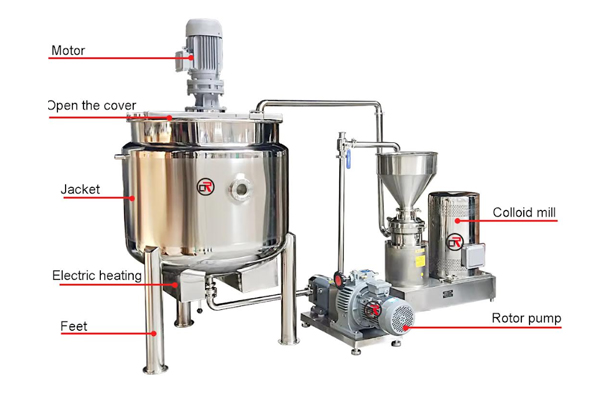MACHINE DESCRIPTION
A top-mounted anchor agitator in a manufacturing vessel, commonly used in industries like pharmaceuticals and cosmetics, works by providing efficient mixing and heat transfer. The anchor-shaped impeller, often made of SS 316L with a mirror polish, rotates within the vessel, creating a swirling motion that ensures thorough blending of ingredients and uniform temperature distribution within the product. The anchor's design, sometimes with PTFE scrapers, helps prevent material from sticking to the vessel walls and ensures efficient mixing.
VESSEL DESIGN AND CONSTRUCTION
- The vessel is typically cylindrical with a dished or hemispherical bottom and a dished top.
- Contact parts, like the anchor and vessel, are made of SS 316L for corrosion resistance and hygiene.
- Non-contact parts, like the vessel's exterior, are often made of SS 304.
- The vessel is designed with features like manholes, nozzles, and valves for easy access and cleaning.
- A jacket is provided for heating and cooling the vessel contents.
AGITATION SYSTEM
- The top-mounted anchor agitator consists of an anchor-shaped impeller, usually made of SS 316L with a mirror polish.
- The anchor is designed to sweep the vessel's bottom and sides, creating a strong swirling or mixing action.
- PTFE scrapers are often attached to the anchor to prevent material buildup on the vessel walls.
- The agitator is driven by a motor and gearbox assembly, often with a Variable Frequency Drive (VFD) for adjustable speeds.
MIXING PROCESS
- The vessel is filled with the desired ingredients.
- The anchor agitator is started, creating a swirling motion that mixes the ingredients thoroughly.
- The jacket is used to heat or cool the vessel contents, maintaining the desired temperature for the process.
- In some cases, a high-speed homogenizer may be used to further refine the mixture.
- The mixing process continues until the desired product consistency and homogeneity are achieved .
ADDITIONAL FEATURES
- Many vessels are equipped with load cells for accurate measurement of the vessel's contents.
- CIP (Cleaning in Place) and SIP (Sterilization in Place) connections are often included for automated cleaning and sterilization.
- Hydraulic lifting mechanisms may be used to raise and lower the top dish for easy access to the vessel's interior for cleaning and maintenance.
